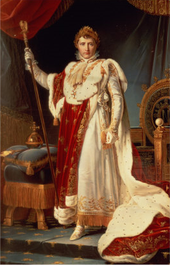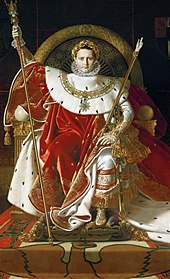The coronation of Napoleon I as Emperor of the French, which took place on Sunday December 2, 1804 (11 Frimaire XIII according to French Republican Calendar), has been said to mark "the instantiation of modern empire", representing "transparently masterminded piece of modern propaganda". On May 18, 1804, the Sénat conservateur vested the Republican government in an Emperor, and preparations for a coronation followed. Napoleon's elevation to Emperor was overwhelming approved by the French citizens in a referendum. Among Napoleon's reasons for coronation were the prestige in internationalroyalist and Catholic milieux and the foundation for future dynasty.
In the classical French tradition kings underwent consecration (sacre) rather than a coronation because of anointment, conferred by the archbishop of Reims.Napoleon blended Roman imperial pageantry with the purported memory of Charlemagne and the coronation was held in Paris in the presence of Pope Pius VII. According to government tallies, the entire cost was over 8.5 million francs.
Preparations
Not wanting to be an Old Regime monarch, Napoleon explained: "To be a king is to inherit old ideas and genealogy. I don't want to descend from anyone... The title of Emperor is greater..." Napoleon wished to hold the coronation on the anniversary of the 18 Brumaire, but Pius VII could not reach Paris in time. He arrived in Paris in November 1804. The task of organizing the coronation was given to the Grandmaster of Ceremonies Louis Philippe, comte de Ségur and the First Chamberlain Auguste Laurent, comte de Rémusat. The music was commissioned from Giovanni Paisiello. The architectsPercier and Fontaine designed the temporary decorations, turning a nunnery cloister into a ballroom. The painter Jean Baptiste Isabey designed the costumes and chemist Philippe le Bon prepared the lighting for the coronation.
According to Louis Constant Wairy, Napoleon woke at eight a.m. To the sound of a cannonade he left the Tuileries at eleven a.m. in a white velvet vest with gold embroidery and diamond buttons, crimson velvet tunic and short crimson coat with satin lining. He wore a wreath of laurel. The number of onlookers, as estimated by Wairy, was between four and five thousand, many of whom had held their places all night, through intermittent showers that cleared in the morning.
The ceremony
The ceremony had started at nine a.m. when the Papal procession set out from the Tuileries. The procession was led by a bishop on a mule holding aloft the Papalcrucifix.The Pope entered Notre Dame first, to the anthem Tu es Petrus, and took his seat on a throne near the high altar. Napoleon's and Joséphine's carriage was drawn by eight bay horses. The two-part ceremony was held at different ends of Notre Dame to emphasize the disconnectedness of religious and secular facets. An unmanned balloon, ablaze with three thousand lights in an imperial crown pattern was launched from the front of Notre Dame during the celebration.
Before entering Notre Dame, Napoleon was vested in a long white satin tunic embroidered in gold thread and Josephine similarly wore a white satin empire style dress embroidered in gold thread. During the coronation he was formally clothed in a heavy coronation mantle, made from crimson velvet, lined with ermine; the velvet was covered with embroidered golden bees, drawn from the golden bees among the regalia that had been discovered in the Merovingian tomb of Childeric I, a symbol that overleapt Charlemagne, ancestor of the Bourbons, to link the new dynasty with the more ancient Merovingians; the bee replaced the fleur-de-lis on imperial tapestries and garments. The mantle weighed at least eighty pounds and was supported by four dignitaries.Josephine was at the same time formally clothed in a similar crimson velvet mantle embroidered with bees in gold thread and lined with ermine, which was borne by Napoleon's three sisters. There were two orchestras with four choruses, numerous military bands playing heroic marches, and over three hundred musicians. A 400-voice choir performed Paisiello's "Mass" and "Te Deum". Because the traditional royal crown had been destroyed during the French Revolution, the so-called Crown of Napoleon, made to look medieval and called the "crown of Charlemagne" for the occasion, was waiting on the altar. While the crown was new, the sceptre was reputed to have belonged to Charles V and the sword to Philip III.
The coronation proper began with the singing of the hymn, Veni Creator Spiritus, followed by the versicle, "Lord, send forth your Spirit" and response, "And renew the face of the earth" and the collect for the Feast of Pentecost, "God, who has taught the hearts of your faithful by sending them the light of your Holy Spirit,..." After this the prayer, "Almighty, everlasting God, the Creator of all..." During the Litany of the Saints the Emperor and Empress remained seated, only kneeling for special petitions. The Emperor and Empress where both anointed on their heads and on both hands with Chrism–the Emperor with the prayers, "God, the Son of God..." and "God who let Hazael triumph over the Syrians...",the Empress with the prayer, "God the Father of eternal glory..."—while the antiphon "Zadok the priest..." was sung. The Mass then began. At Napoleon's request the collect of the Blessed Virgin (as the patron of the cathedral) was said in place of the proper collect for the day. After the epistle the different articles of the imperial regalia were individually blessed, and delivered to the Emperor and Empress.At the moment of the crowning when the Pope said, "Receive the imperial crown..." Napoleon unexpectedly turned and, forestalling the Pope, removed his laurel wreath and crowned himself and then crowned the kneeling Joséphine with a small crown surmounted by a cross, which he had first placed on his own head. At Napoleon's enthronement the Pope said, "May God confirm you on this throne and may Christ give you to rule with him in his eternal kingdom".Limited in his actions, Pius VII proclaimed further the Latin formula "Vivat imperator in aeternum!" (May the Emperor live forever!), which was echoed by the full choirs in a Vivat, followed by "Te Deum". With his hands on the Bible, Napoleon took the oath:
- "I swear to maintain the integrity of the territory of the Republic, to respect and enforce respect for the Concordat and freedom of religion, equality of rights, political and civil liberty, the irrevocability of the sale of national lands; not to raise any tax except in virtue of the law; to maintain the institution of Legion of Honor and to govern in the sole interest, happiness and glory of the French people".
The text was presented to Napoleon by the President of the Senate, the President of Legislature and the most senior President of the Council of State. After the oath the newly appointed herald of arms proclaimed loudly: "The thrice glorious and thrice august Emperor Napoleon is crowned and enthroned. Long live the Emperor!" During the people's acclamations Napoleon, surrounded by dignitaries, left the cathedral while the choir sang "Domine salvum fac imperatorem nostrum Napoleonem"—"God save our Emperor Napoleon".
After the coronation the Emperor presented the imperial standards to each of his regiments.
In addition to David's paintings, a commemorative medal was struck with the reverse design by Antoine-Denis Chaudet.



